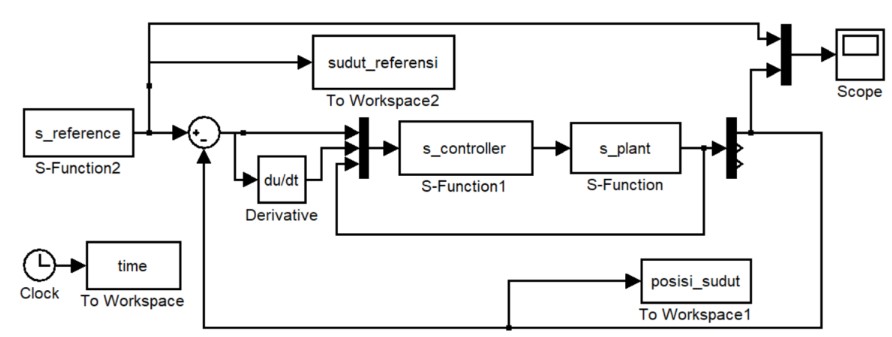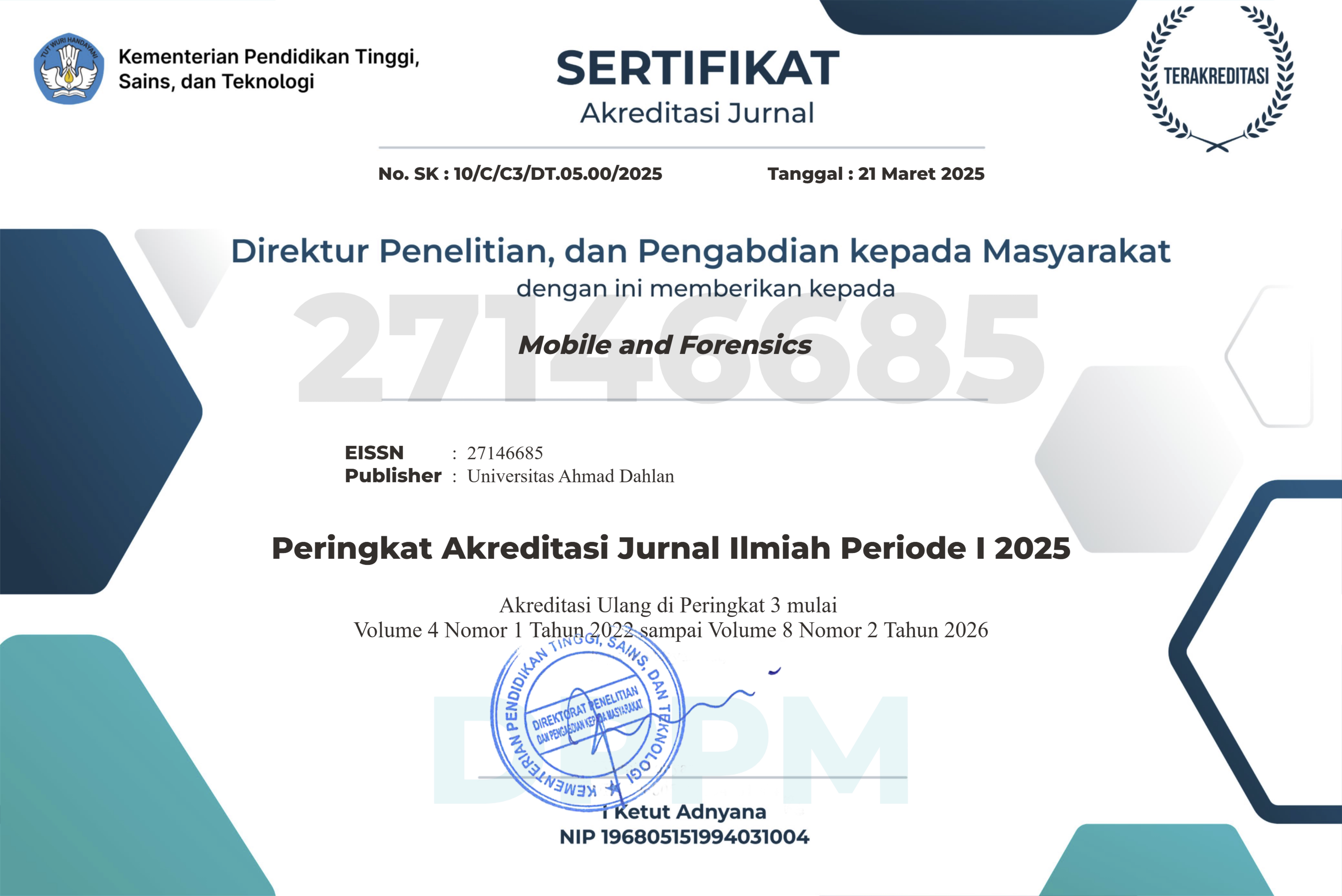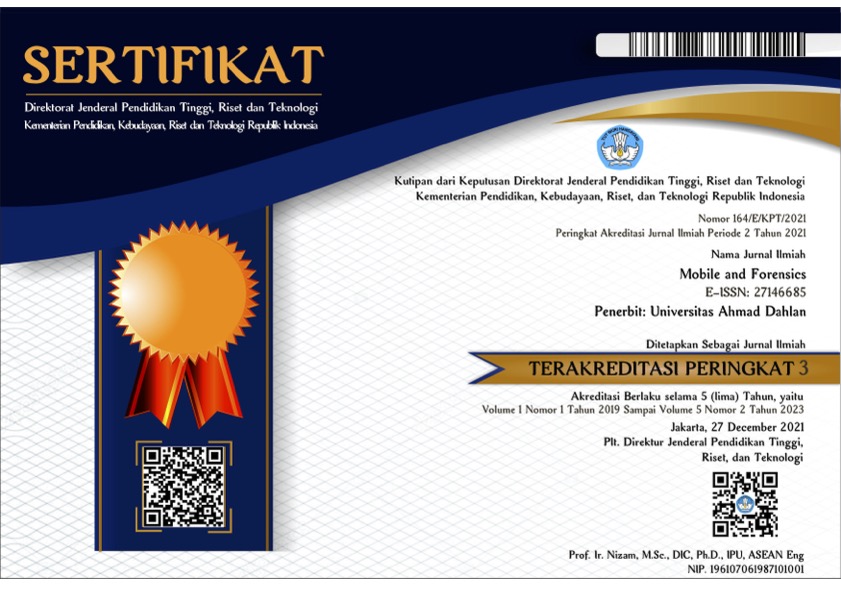Kendali Linierisasi Umpan Balik pada Sistem Pendulum Terbalik
DOI:
https://doi.org/10.12928/mf.v2i2.2828Keywords:
Pengendali umpan balik linierisasi, Pendulum terbalik, nir linier.Abstract
Pada penelitian ini diterapkan pengendali linierisasi umpan balik pada sistem pendulum terbalik yang memiliki karakteristik tidak linear dan tidak stabil. Berdasarkan pada pengujian, pengendali yang diusulkan mampu untuk membuat sistem mengikuti sinyal referensi undak dan sinus. Nilai respons sistem untuk sinyal referensi undak adalah waktu naik sebesar 4,0386; waktu kestabilan sebesar 3,4656 dan overshoot sebesar 0 persen. Oleh karena itu dapat disimpulkan bahwa pengendali umpan balik linierisasi mampu untuk mengendalikan sistem pendulum terbalik mengikuti sinyal referensi.
In this study, a feedback linearization controller was applied to an inverted pendulum system that has non-linear and unstable characteristics. Based on the test, the proposed controller is able to make the system follow step and sine reference signals. The system response value for the step reference signal is an increment time of 4.0386; the time of stability was 3,4656 and overshoot was 0 percent. Therefore, it can be concluded that the linearized feedback controller is able to control the inverted pendulum system following the reference signal.
References
K. Ogata, Modern Control Engineering. Prentice Hall, 2010.
B. Kim and B. Park, "Robust Control for the Segway with Unknown Control Coefficient and Model Uncertainties," Sensors, vol. 16, no. 7, p. 1000, Jun. 2016.
A. Maarif, R. D. Puriyanto, and F. R. T. Hasan, "Robot Keseimbangan dengan Kendali PID dan Kalman Filter," IT JOURNAL RESEARCH AND DEVELOPMENT, vol. 4, no. 2, Feb. 2020.
H. O. Erkol, "Optimal PIλ Dμ controller design for two wheeled inverted pendulum," IEEE Access, vol. 6, pp. 75709-75717, 2018.
J. F. S. Trentin, S. Da Silva, J. M. De Souza Ribeiro, and H. Schaub, "Inverted Pendulum Nonlinear Controllers Using Two Reaction Wheels: Design and Implementation," IEEE Access, vol. 8, pp. 74922-74932, 2020.
S. K. Valluru and M. Singh, "Stabilization of nonlinear inverted pendulum system using MOGA and APSO tuned nonlinear PID controller," Cogent Engineering, vol. 4, no. 1, Jul. 2017.
R. Uswarman, A. I. Cahyadi, O. Wahyunggoro, R. Uswarman, A. I. Cahyadi, and O. Wahyunggoro, "Design and Implementation of a Magnetic Levitation System Controller using Global Sliding Mode Control," Journal of Mechatronics, Electrical Power, and Vehicular Technology, vol. 5, no. 1, p. 17, Jul. 2014.
R. Uswarman, S. Istiqphara, R. A. Yunmar, and A. Z. Rakhman, "Robust Control of a Quadcopter Flying Via Sliding Mode," Journal of Science and Application Technology, vol. 2, no. 1, pp. 135–143, Jun. 2019.
A. Ma’arif, A. imam Cahyadi, and O. Wahyunggoro, "CDM Based Servo State Feedback Controller with Feedback Linearization for Magnetic Levitation Ball System," International Journal on Advanced Science, Engineering and Information Technology, vol. 8, no. 3, p. 930, Jun. 2018.
H. K. Khalil, Nonlinear Systems: Pearson New International Edition. Pearson Education Limited, 2013.
A. Ma’arif, A. I. Cahyadi, O. Wahyunggoro, and Herianto, "Servo state feedback based on Coefficient Diagram Method in magnetic levitation system with feedback linearization," in 2017 3rd International Conference on Science and Technology - Computer (ICST), 2017, pp. 22–27.
J. Liu and X. Wang, Adaptive Sliding Mode Control for Mechanical Systems: Design, Analysis dan Matlab Simulation. Tsinghua University Press and Springer, 2011.

Downloads
Published
Issue
Section
License
Copyright (c) 2020 Alfian Ma'arif

This work is licensed under a Creative Commons Attribution-ShareAlike 4.0 International License.
Start from 2019 issues, authors who publish with JURNAL MOBILE AND FORENSICS agree to the following terms:
- Authors retain copyright and grant the journal right of first publication with the work simultaneously licensed under a Creative Commons Attribution License (CC BY-SA 4.0) that allows others to share the work with an acknowledgment of the work's authorship and initial publication in this journal.
- Authors are able to enter into separate, additional contractual arrangements for the non-exclusive distribution of the journal's published version of the work (e.g., post it to an institutional repository or publish it in a book), with an acknowledgment of its initial publication in this journal.
- Authors are permitted and encouraged to post their work online (e.g., in institutional repositories or on their website) prior to and during the submission process, as it can lead to productive exchanges, as well as earlier and greater citation of published work.

This work is licensed under a Creative Commons Attribution-ShareAlike 4.0 International License.












 Mobile and Forensics (MF)
Mobile and Forensics (MF)